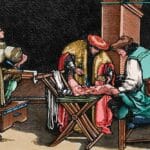Ever heard of the Knights Templar? You probably picture brave knights fighting in the Crusades. But these guys were also running a massive, sophisticated banking system way back in medieval times! They were like the Wall Street of their day, making loans, transferring money across Europe, and even inventing early versions of things we use today. This story isn’t just about history; it’s about how brilliant business strategies can build empires, and how even the mightiest can fall. We’ll explore their ingenious money moves, how they changed the world of finance, and what lessons we can learn from their incredible rise and dramatic fall—lessons that are still relevant in today’s financial world. For comparison, consider ancient legal codes like [the Code of Hammurabi](https://www.lolaapp.com/the-code-of-hammurabi-an-ancient-legal-system-of-an-eye-for-an-eye). Get ready for a fascinating look into the surprisingly modern world of medieval banking!
The Knights Templar: From Holy Warriors to Europe’s First Bankers & Medieval Finance Pioneers
The Knights Templar. You probably picture them as brave, holy warriors, charging into battle in the Crusades. And they were that, but their story is so much bigger, more surprising, and frankly, more interesting. They were also, believe it or not, Europe’s first real bankers, long before anyone had even heard of a checking account. How did a band of warrior-monks become financial giants, and what are the key aspects of their rise in medieval finance? Let’s dive in.
From Holy Vows to Financial Masters of Medieval Banking
Imagine life in the 12th century. Travel was dangerous, especially to the Holy Land. Pilgrims carried their life savings, often in the form of heavy bags of gold coins – an enticing prize for bandits. This is where the Knights Templar stepped in. Initially founded around 1119 by Hugues de Payens and a small group of knights to protect pilgrims traveling to Jerusalem, their role quickly expanded. Their vast network of castles and fortified commanderies, spread across Europe and the Middle East, became incredibly safe havens for pilgrims’ money and valuables. Think of it as the ultimate medieval travel insurance, with seriously well-armed guards.
This wasn’t just a matter of safekeeping. The Templars were smart. They realised they could do more than just protect treasure; they could manage it. This led to them developing ingenious ways to handle large sums of money, laying the groundwork for modern finance.
A Medieval Banking Network: Castles, Commanderies, and Cash Flow Innovation
Their strongholds weren’t just fortresses; they were branches of a sophisticated financial network. These strategically placed castles and commanderies provided a level of security unseen anywhere else in Europe. Pilgrims could deposit their money in one location and withdraw it at another, miles away, without having to carry it along dangerous routes. This was groundbreaking. Instead of lugging around heavy purses of gold, travelers could carry a letter from the Templars, guaranteeing their funds were available at their destination. This network helped fuel economic activity during the Crusades and beyond.
Letters of Credit: The Medieval Check and Financial Security
This ingenious system is what is known as a “letter of credit” (a document guaranteeing payment). Imagine a check, but instead of your bank’s assurance, it was the Knights Templar’s vouching for you. These letters revolutionized how money moved across Europe. They reduced the risks of robbery, streamlined trade, and became a far more efficient way to handle large-scale transactions than hauling gold across battle-scarred lands. The Templars were essentially the “Western Union” of the Crusades, as noted by Financial Times columnist Tim Harford.
Lending a Hand (and a Lot of Money): Royal Clients, Papal Favors, and High-Finance
The Templars’ financial savvy didn’t stop with safekeeping and transfer of funds. They became incredibly powerful lenders, providing loans to kings, princes, and even the Pope himself. These were not small loans; we’re talking about enormous sums that fueled wars, built cathedrals, and fundamentally shaped the political landscape of Europe. This gave them immense influence and solidified their position as major players in the financial world. Think of them as the ultimate medieval investment firm, albeit one with a slightly more pious, and more heavily armed, investor base. King Henry III of England, for example, used the Templars to broker the purchase of the island of Oleron in the 1200s.
Now, there is some debate surrounding their lending practices. Did they always adhere to modern standards of ethical banking? Probably not. Interest rates were complex, and what might be considered “usury” (the practice of lending money at unreasonably high interest rates) today was acceptable, if not commonplace, back then. Research continues to uncover more about their financial dealings, and our understanding of their practices is constantly evolving.
The Templar’s Financial System: More Than Just a Few Coins and Wealth Management
Managing their massive wealth required organization. The Templars developed remarkably sophisticated accounting systems for their time. They meticulously collected taxes, managed vast estates, and strategically invested in various enterprises. We don’t have all the details of their accounting practices, obviously – imagine trying to find perfectly preserved documents from the 13th century! – but evidence shows a level of financial organization unheard of in those days. They were early adopters of what we’d now call financial diversification – and good thing too, protecting them from total collapse.
The Fall of the Templars: A Cautionary Tale & Lessons in Financial Risk
Despite their pioneering role in finance and their immense power and influence during the Middle Ages, the Templars’ story takes a dramatic turn. In the early 14th century, King Philip IV of France, heavily indebted to the order, accused them of heresy and financial wrongdoing. On Friday, October 13, 1307, hundreds of Templars across France were arrested in a coordinated operation. This event, occurring on a Friday the 13th, is often cited as the origin of the superstition surrounding that date. These accusations, likely fueled by Philip’s desire to seize the Templars’ vast wealth, resulted in the order’s brutal suppression. This sad tale showcases the precarious nature of power, even for an organization as influential as the Knights Templar. The exact reasons behind their downfall are still subjects of scholarly debate, but it likely came from a mix of internal troubles and clever political maneuvers.
A Lasting Legacy: The Templars’ Impact on Finance & Modern Banking
Even though their story ended tragically, the Knights Templar’s contributions to the development of finance are undeniable. Their innovations in secure storage, money transfer, and lending laid the foundation for many banking practices we still use today. Their story is a powerful reminder of the fascinating interplay between religion, power, and money in medieval Europe. They were pioneers; and while some aspects of their story are still shrouded in mystery, their impact is undeniably clear. The Knights Templar weren’t just about swords and piety; they were also about shrewd business and financial ingenuity. Their legacy remains a compelling blend of the holy and the financial, raising critical questions that continue to resonate even today. What lasting impact did the Knights Templar have on the evolution of banking systems in Europe?
How Did the Knights Templar’s Accounting Practices Prevent Fraud? & Banking Security
Key Takeaways:
- The Knights Templar developed sophisticated record-keeping systems for their time.
- Their network of commanderies facilitated efficient asset management and minimized risk.
- How did the knights templar’s accounting practices prevent fraud? A combination of internal controls, secure storage, and a strong reputation for financial integrity played a crucial role.
- The Templars’ system of checks and balances and detailed receipts helped maintain accountability.
- Their eventual downfall highlights the vulnerability of even the most robust systems to political pressures and accusations.
A Network of Trust: The Templar Financial Infrastructure & International Finance
The Knights Templar weren’t just warriors; they were pioneers of medieval finance. Their success stemmed from a brilliantly designed system. Imagine a vast, interconnected network of commanderies—essentially, fortified branches—spanning Europe and the Middle East. This wasn’t just for military strategy; it was a logistical masterpiece for managing enormous wealth. Each commandery acted as a node, receiving, storing, and transferring funds with precision. This decentralized system, while seemingly risky, inherently lowered the risk of large-scale theft or fraud targeting a single location.
Record-Keeping: The Medieval Spreadsheet & Financial Accountability
How did the knights templar’s accounting practices prevent fraud? Their meticulous record-keeping was a crucial element. We’re not talking about simple ledgers here. The Templars employed a complex system of receipts, accounting records, and audits. Every transaction, no matter how small, was documented. These weren’t just numbers on a parchment. They were a detailed audit trail designed to prevent manipulation and maintain transparency. This level of financial transparency was unprecedented for its time. Consider this: the order’s international network required a standardized system. That alone hints at a sophisticated understanding of internal controls.
Letters of Credit: The Medieval ATM & Secure Transactions
The Templars also developed a system akin to the modern letter of credit – a secure method for transferring funds over long distances. Pilgrims traveling to the Holy Land could deposit funds at one commandery, receive a letter of credit, and redeem it at another, safe from the dangers of carrying large sums of cash. This innovation provided security for individuals and reduced the risk of theft while simultaneously streamlining the transfer of vast wealth across their vast network. This further reinforced their reputation for trustworthiness.
The Fall of the Templars: A Cautionary Tale & Financial System Vulnerabilities
The story of the Knights Templar serves as a cautionary tale, illustrating that even the most cleverly designed systems can fail. While their financial acumen was remarkable, their immense wealth eventually attracted unwanted attention from King Philip IV of France. Accusations of heresy and financial irregularities, fueled by political machinations, led to their downfall. The suppression of the order, regardless of the validity of the accusations, emphasizes the vulnerability of even the most meticulously designed financial systems to external threats and political maneuvering. How did the Templars use letters of credit to secure transactions?
Templar Financial Strategies in the Holy Land and Europe & Economic Activity
Key Takeaways:
- The Knights Templar, a military order, unexpectedly became pioneers of medieval finance.
- Templar Financial Strategies in the Holy Land and Europe involved sophisticated systems for managing vast wealth.
- Their innovations impacted medieval commerce and laid the groundwork for modern banking.
- Their success stemmed from their extensive network, secure infrastructure, and the high demand for financial services during the Crusades.
- The Templars’ downfall highlights the risks associated with unchecked power and wealth.
A Network of Trust: The Templar Infrastructure & Financial Security
Imagine a world without banks. That was the medieval reality for most. Enter the Knights Templar, a military order who, surprisingly, became masters of managing money. Their success wasn’t accidental. They built a sophisticated network across Europe and the Holy Land. Their commanderies, essentially fortified branches, served as secure storage facilities for valuables. Pilgrims and merchants alike deposited their money, knowing it was safe. It was an early form of international banking, predating similar systems in Italy by centuries, as some historians note. How did the Templars create an early form of international banking?
Financial Innovations: Early Banking Techniques & Money Transfers
How did the Templars maneuver around the ban on usury (charging interest)? They were clever. They used creative methods to generate profit. Templar Financial Strategies in the Holy Land and Europe included the use of letters of credit – essentially early checks – enabling safe and efficient money transfers across vast distances. They also offered money exchange services, profiting from fluctuating exchange rates. Their meticulous records – far superior to most contemporary institutions – contributed to their efficiency and reliability. Their system facilitated the movement of funds for the Crusades and general commerce. The order’s list of clients included not only pilgrims, but also the English nobility and even the Pope, further cementing their reputation and reach.
Beyond Safekeeping: Lending and Investment & Asset Growth
While primarily acting as custodians and facilitating transfers, the Templars also engaged in lending, though not explicitly charging interest. This involved financing ventures and offering loans to kings and nobles. This wasn’t charity; these loans came with fees and created profitable partnerships. They were shrewd investors, involved in land acquisition and other ventures that multiplied their assets. Therefore, their role expanded beyond simple safekeeping, pushing the boundaries of medieval finance.
The Seeds of Their Downfall: Wealth, Power, and Suspicion & Corruption Scandals
Their considerable wealth and influence, however, ultimately proved their undoing. Accusations of heresy and corruption, often fuelled by envious rivals, led to their persecution and demise. Their secrecy became a liability when confronted with royal demands for accounting. Their story demonstrates that innovation, even in finance, can have far-reaching and sometimes unforeseen consequences. King Philip IV of France, deeply in debt to the Order, orchestrated their downfall in a bid to seize their assets.
Lessons from the Past: Relevance to Modern Finance & Ethical Guidelines
The Templars’ story isn’t just a historical curiosity. It offers valuable lessons. Templar Financial Strategies in the Holy Land and Europe provide an early example of the complex relationship between finance, power, and religion. Their eventual downfall underscores the importance of transparency, regulation, and ethical considerations in financial institutions—lessons that remain relevant today. Their story serves as a cautionary tale and a source of inspiration for modern finance. What role did ethical considerations play in the downfall of the Knights Templar?
Comparative Analysis: Templar Land Acquisition and Medieval Real Estate Practices & Wealth Accumulation
Before delving into the Templars’ financial prowess, let’s consider the foundation of their wealth: land. How did they acquire it, and how did their methods compare to other landowners of the era?
Templar Land Acquisition: A Strategic Approach & Investment Strategies
The Knights Templar weren’t just warriors; they were shrewd investors. Their land acquisition wasn’t haphazard. It was a calculated strategy, fueled by donations and strategic purchases. Wealthy patrons, pious individuals, and even monarchs gifted land to the Order, securing divine favor and bolstering their reputation. Simultaneously, the Templars cleverly purchased properties, often strategically located near vital trade routes or agricultural hubs. This wasn’t mere real estate speculation; it was a long-term investment in their infrastructure. Their vast network of preceptories, strategically positioned across Europe and the Middle East, served as both military outposts and financial centers.
Medieval Real Estate Practices: A Diverse Landscape & Land Ownership
Medieval real estate wasn’t standardized. Ownership varied greatly depending on local customs and feudal hierarchies. The Church, nobility, and wealthy merchants held significant land. Acquisition methods included inheritance, grants from the Crown, purchase, and sometimes, less-than-legal means. Fragmentation of land ownership was common, making large-scale projects complex. Unlike the Templars’ centralized control, many landowners relied on local managers, leading to potential inefficiencies. Transactions were often informal, with agreements based on oral contracts and local traditions rather than formal paperwork.
A Comparative Glance: Templar Efficiency vs. Medieval Norms & Management Systems
Comparative Analysis: Templar Land Acquisition and Medieval Real Estate Practices directly reveals significant differences. The Templars, with their centralized administration and robust bookkeeping (relative to the era), developed remarkably efficient land management systems. This contrasted greatly with the often-fragmented and inefficient practices of other landowners. Their standardized procedures, combined with their vast network, allowed them to optimize resource allocation and agricultural production far more effectively. Think of it as a medieval multinational corporation versus a collection of independent family farms. The Templars’ success wasn’t solely due to sheer patronage; their internal organization played a crucial role.
The Templars’ Agricultural Prowess & Revenue Generation
Their lands weren’t just for show; they were significant revenue generators. The Templars focused on profitable ventures, such as wool production and grain cultivation. Their lands were managed efficiently, generating substantial income for the Order – income that fueled their burgeoning financial activities. They excelled in agricultural production, supplying not only themselves but also wider markets. This output was a key component of their financial empire, supporting their other ventures and providing a stable foundation for their wealth.
The Downfall: A Warning from History & Political Instability
The Templars’ downfall serves as a stark example of the perils of unchecked power, even in a financial context. Their immense wealth and influence made them a target for those wanting to seize their assets. Philip IV of France, a powerful king in desperate need of funds, used fabricated accusations to crush the Order and claim its resources. Their story highlights the complex interplay of religion, power, and money. It also demonstrates the inherent risks associated with accumulating significant wealth within a politically unstable environment. The destruction of the Templars did not erase their influence, however. Their financial innovations laid the groundwork for modern banking, and their military traditions inspired later chivalric orders.
Key Takeaways:
- The Templars developed sophisticated land management strategies, exceeding the norms of their era through efficient organization and centralized control.
- Their centralized system contrasted sharply with the more fragmented land ownership and management practices of other medieval entities.
- The Templars’ agricultural successes contributed significantly to their financial strength, making them a target for powerful figures.
- The rapid decline following their suppression underscores the importance of sound governance and risk management, even for seemingly powerful organizations. What financial lessons can we learn from the land acquisition strategies of the Knights Templar?
- Uncover Vo Nguyen Giap: The Vietnamese General Who Defeated France and the USA: Strategic Mastermind - August 2, 2025
- Discover the Bristlecone Pine: Earth’s Oldest Living Organisms, a 5,000-Year Story of Resilience - August 2, 2025
- Understand the Dunning-Kruger Effect: Why Incompetent People Think They’re Experts: Gain Self-Awareness - August 1, 2025














